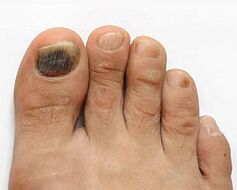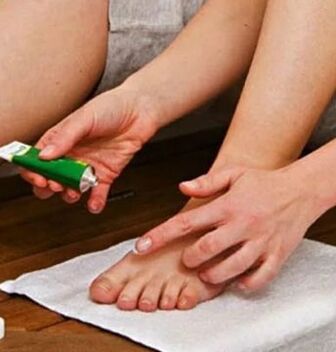
Fungal disease is often diagnosed in dermatology. Walking barefoot on the beach, lack of changeable shoes when visiting saunas and baths, trying on shoes, boots from other people, etc. , contribute to the wide spread of the disease in the toes. starts with the thumb. This is due to the peculiarity of the anatomical structure of the nail and a significant subungual space. If you seek medical help in a timely manner, the disease will not bring you much discomfort and will be nothing more than a temporary cosmetic defect.
disease symptoms
Getting under the nail plate, the fungal infection quickly finds a nutrient medium for itself and begins active reproduction. During this period, a person may not experience any symptoms, or a slight itching, redness in the nail area appears. In addition, the growth of colonies of pathogens leads to more pronounced signs, they are the reason to seek advice from a medical institution. If you treat toenail fungus in the big toe at the early stage, then you can avoid many unpleasant complications. The main symptoms include:
- change in nail color;
- the appearance of spots under it;
- lack of natural shine;
- greater fragility;
- nail deformity.
The longer the disease is not treated, the more negative the effect of the fungus: the body of the nail becomes thick, its shape changes a lot. Such a toe causes pain when trying to put on tight shoes or in case of accidental mechanical injury. In the future, the nail completely loses its healthy appearance, collapses, exfoliates and can come out of the nail bed.
Causes of fungus on the big toe
The causative agent of the disease are three groups of pathogenic fungi: yeast, mold and dermatomycetes. Its prevalence in the environment is extremely high, so there can be many forms of infection. However, not all people become infected with dangerous contact, as immunity acts to protect health. Treatment for fungus on the big toe is usually necessary for people with reduced resistance to infections of this type. In addition, the disease can be caused by:

- frequent thumb injury;
- non-compliance with hygiene standards;
- the presence of fungal skin lesions;
- diabetes;
- overweight;
- vascular diseases;
- varicose veins of the lower extremities.
Weak immunity occupies a special place among predisposing factors. Past viral infections, frequent colds, sore throats, poisoning deprive the body of its defenses against a fungal infection and increase the risk of infection. In addition, the lack of nutrients and the frequent formation of cracks and other lesions in the region of the big toe reduce local immunity and can lead to illness.
Which doctor should I contact?
If you have started to worry about any unpleasant symptoms associated with toenails, you should seek medical advice as soon as possible. Itching, redness, discoloration can indicate an impending illness. Qualified assistance in this matter will be provided by a physician.
He specializes in various skin diseases and will help to competently treat big toe nail fungus. First, a comprehensive diagnosis is performed, including taking a history, examination, and passing some laboratory tests. For a more complete assessment of the patient's condition, the dermatologist can define several questions:
questions:
- How long have you noticed changes in your nails?
- What was the first thing to worry about?
- Has the nail plate changed color?
- How long did it take for the form to change?
- What kind of activity are you doing?
- Do you often visit saunas, baths?
- Have you ever had a fungal infection of the body?
After undergoing further examinations, the patient will need to visit a dermatologist again. Based on the results obtained and the clinical picture, the doctor prescribes therapy for the disease.
Treatment
The effectiveness and duration of therapy for the disease directly depend on the early seeking of medical help and the correct regimen. At the initial stage of the disease, ointments and gels for external use containing an antifungal component are effective means. In this case, it is important to correctly identify the pathogen and deal with it. Other treatments are also possible:
- complex therapy;
- physiotherapeutic effect;
- laser therapy;
- nail removal;
- elimination of comorbidities.
In more complex cases of pathology, an integrated approach is shown, including antifungal drugs for local and internal use, general tonic. An adjunct to drug treatment is a low-sugar diet. It is he who creates favorable conditions for the reproduction of parasitic fungi. For a faster recovery process, we recommend:
- take vitamin complexes;
- live an active lifestyle;
- perform daily hygiene procedures;
- strictly follow the treatment regimen;
- refuse bad habits.
An important place in the final stage of therapeutic measures is the prevention of relapses and the strengthening of immunity. Patients are not advised to walk barefoot on the beach, try on other people's shoes and allow frequent sweating of the feet.
Possible complications
An aesthetic defect is far from all that a fungus is capable of. In advanced conditions, the nail becomes excessively large, extremely painful, grows into the adjacent skin, it is possible that a secondary infection and a purulent lesion may come together. Treating nail fungus in this case will be a long and laborious process. In addition to the local negative impact, pathogens have a devastating effect on the entire organism, they are possible:
- allergies;
- dermatitis;
- blood poisoning;
- intoxication;
- somatic diseases.
When the fungal strains reach large numbers, their residues become poison, poisoning a person and depriving their immune system of defenses. In this state, the probability of various viral or bacterial lesions is very high. There is a marked deterioration in overall health and performance.















